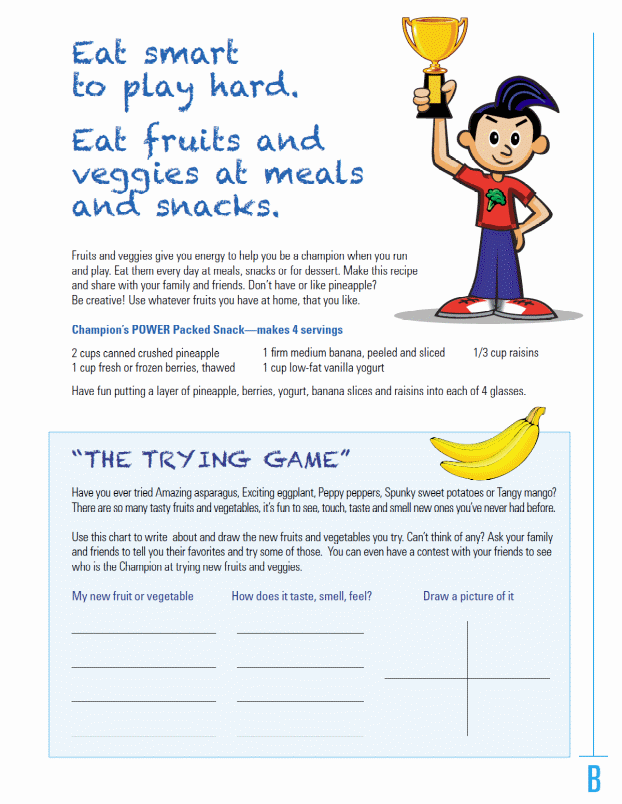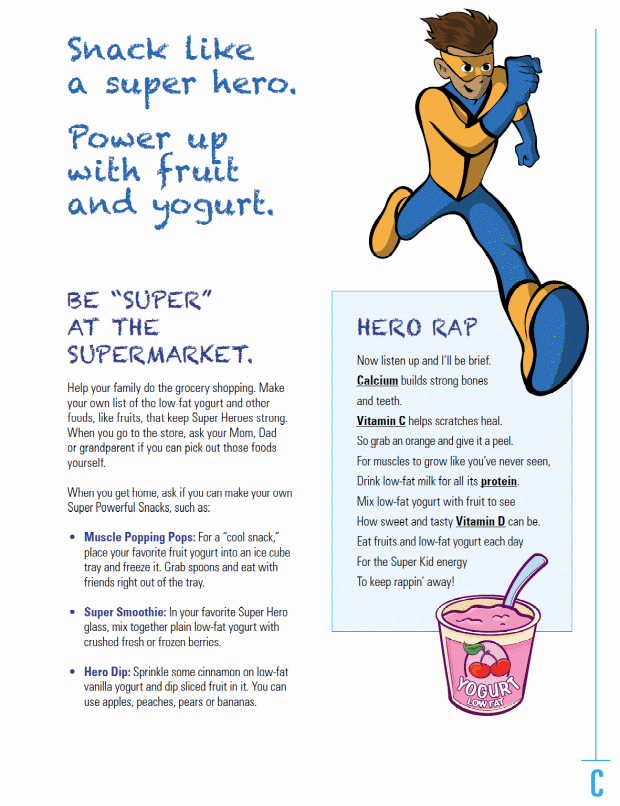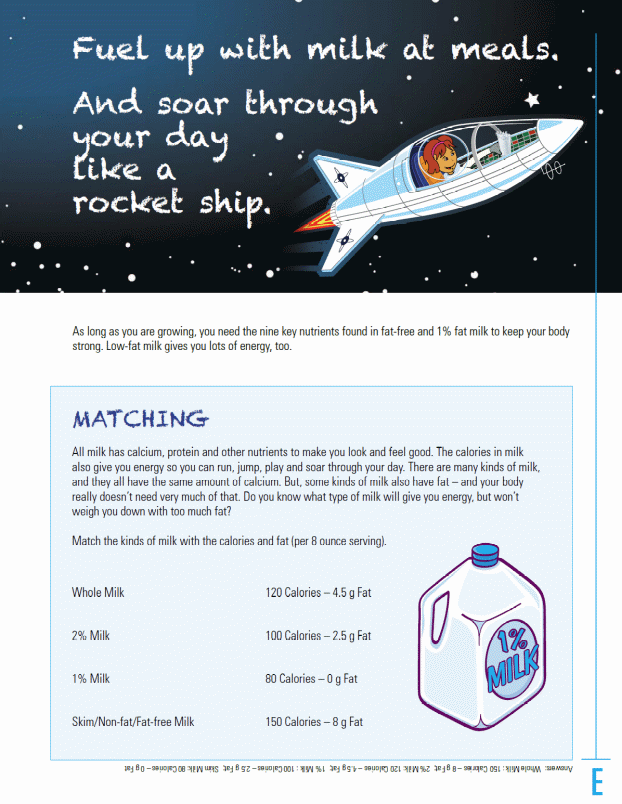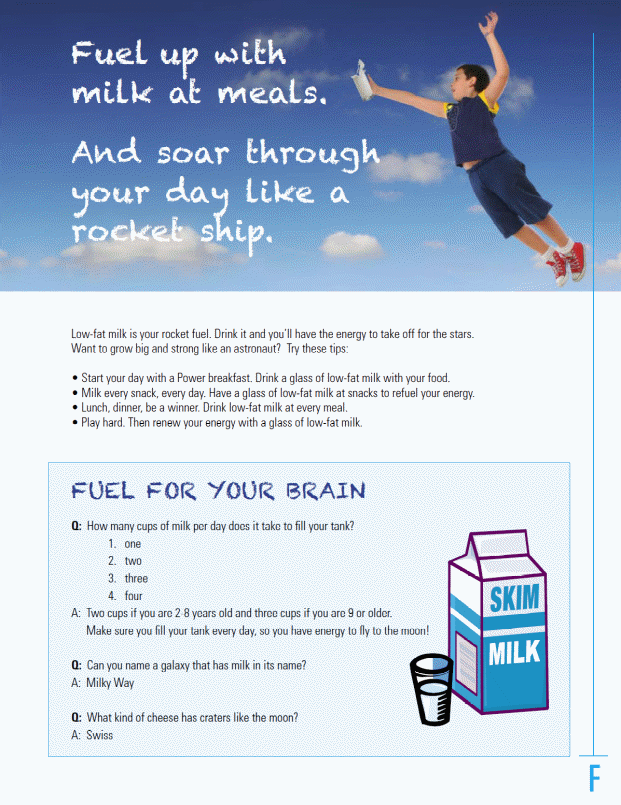Moderator Guide Childre 8-10 Years
F - Kids ages 8 to 10 Guide_supporting content_form. Attachment F19.28.10.doc
Generic Clearance to Conduct Formative Research
Moderator Guide Childre 8-10 Years
OMB: 0584-0524
OMB BURDEN STATEMENT: According to the Paperwork Reduction Act of 1995, no persons are required to respond to a collection of information unless it displays a valid OMB control number. The valid OMB control number for this information collection is 0584-0524. The time to complete this information collection is estimated to average 60 minutes per response, including the time for reviewing instructions, searching existing data sources, gathering and maintaining the data needed, and completing and reviewing the collection of information.
USDA/FNS Formative Messaging
Mini Focus Group Moderator’s Guide (Low-income Children 8-10 years of age)
Milk and Fruits/Vegetables Messages
ON-SITE, INFORMAL DISCUSSION WITH CHILDREN TO MAKE THEM COMFORTABLE WITH THE SURROUNDINGS (5 minutes)
i. WELCOME AND GROUND RULES
[OMB Statement read to parents and children before groups begin]
First of all, I want to thank you for coming in today. My name is and I am very excited that you could all join us, and we should have a fun discussion. The group discussion will last only one hour. Do any of you need anything before we start? If you need to go to the bathroom during the next hour just let me know and a co-worker will show you where it is.
Have any of you ever been to a group discussion like this before? Moderator to review and explain to the kids the details of the room.
Well, I want to tell you a few things before we begin. There are microphones in the room that are recording what is said. I have to write a report after I am done today, and it makes it easy for me to be able to go back and listen to everything we talked about.
Behind me is a one-way mirror, which means there are a few people behind the mirror watching. A few other people working on this project with me are observing this discussion and taking notes since I can’t write down everything you say.
Because we are taping, it is important that you try to speak one at a time. It is my only “rule” of the day. So if everyone can be polite and try not to talk over each other I would appreciate it. It will also help the people taking notes to not hear everyone talking one at a time!
Before we start I want everyone to know that there are no wrong answers. We just want to hear your most honest thoughts, so don’t worry if you have different ideas or opinions than someone else in the group. The more thoughts you can share the better! I know you all have great thoughts to share and I can’t wait to hear them.
II. INTRODUCTIONS (5 minutes)
Ok, so now that I have told you all about the room, let’s take a minute before we start to introduce ourselves. Moderator to go first by saying name again and fun fact about himself- for example favorite thing to do in his free time.
Ok, so now that you know a little bit about me, I would love to hear all about you! Let’s go around the room and everyone can just say their first name, age and grade as well as their favorite activity.
What are some types of things you do when you are not at school? [USE TO GAUGE MEDIA USAGE, PROBE: Television, Internet (what sites do you visit), IM, read magazines (which ones)?] Where do they access the internet?
III. PERCEPTIONS OF HEALTH/NUTRITION (5 minutes)
Today we are going to be talking about health and nutrition. We will also be showing you some ideas for posters and games that people have made to try to explain health and nutrition to you. We want to know what you think of them to help us understand how to make them better for kids your age.
Let’s start by talking about health and nutrition.
First, how important is it to be healthy, and why?
Let’s make a list. [MODERATOR GO TO EASEL:] What are some things you do to be healthy?
Let’s take a look at the things you said. [MODERATOR LOOK FOR EATING/DRINKING HEALTHY THINGS. IF NOT LISTED ASK: What about things you eat and drink? Is there anything about eating or drinking that can be healthy?]
What do you think the phrase “healthy foods” means?
Can you give me some examples of healthy foods?
How do you know that they are healthy?
Do you think it matters if you eat or drink healthy? Why or why not?
IV. LEARNING ABOUT HEALTHY EATING (5 minutes)
I want to spend some time talking about the different ways you have learned about nutrition and healthy eating.
When and where do you hear advice about what to eat or drink?
PROBE: Home, School, After-school program, Sports team, Community center, Grocery store, TV shows, magazines, Online/websites
Where are you most likely to pay attention to this type of advice? [Probe specific channels in school – cafeteria, morning announcement, school menu, school health fair, etc.]
What type of advice do you get about what to eat or drink?
PROBE: favorite foods, eating healthy [ask for specifics]
What are some fun ways that you have learned about eating healthy foods?
PROBE: handouts/worksheets, school cafeteria tray liners, specific websites
V. PERCEPTIONS OF SUPPORTING CONTENT (30 min)
As I mentioned earlier, we want to get your opinion on specific ideas for teaching healthy eating to children like you.
Take a quick look through this material [DISTRIBUTE PACKET OF SUPPORTING CONTENT]. Look through all of the materials and put a mark on the pages that you would want to come back to.
[A TOTAL OF 6 EXAMPLES OF SUPPORTING CONTENT WILL BE INCLUDED. PROBING QUESTIONS WILL BE ROTATED TO FOCUS ON JUST 3 MATERIALS PER SESSION.]
ROTATION SCHEDULE:
Location, Group |
Discussion rotation |
Chicago, IL – Group 1 |
A, B, C |
Chicago, IL – Group 2 |
D, E, F |
Dallas, TX – Group 3 |
F, B, D |
Dallas, TX – Group 4 |
C, A, E |
Birmingham, AL – Group 5 |
B, D, A |
Birmingham, AL – Group 6 |
F, C, E |
A: First supporting content related to fruits/vegetable message (tips & jokes)
B: Second supporting content related to fruits/vegetable message (recipe and chart to keep track of likes)
C: First supporting content related to fruit & yogurt message (tips & rap)
D: Second supporting content related to fruit & yogurt message (text and matching game)
E: First supporting content related to milk message (text and matching game)
F: Second supporting content related to milk message (tips & quiz)
What is your first reaction to the material you just looked through?
Which pages did you mark that you would want to come back to? Why did you pick those pages?
[ASK QUESTIONS BELOW, AS APPROPRIATE ACCORDING TO DISCUSSION ROTATION]
(A) Did you pick the fruit and veggie snack ideas and jokes? Why did you mark that page?
What did you like about it?
What did you not like about it?
How likely would you be to use these tips?
Do you think you will tell these jokes to your friends? Why or why not?
What, if anything was confusing about it or difficult to understand?
What are the tips and jokes trying to tell you about fruits and veggies?
(B) Did you pick the recipe and fruit and veggie chart? Why or why not?
How often do you make/get your own snack?
How do you feel about preparing/making your own foods or helping to prepare food?
How often do you make things/cook with your mom or dad or someone else?
How likely would you be to use/share a recipe with your mom and dad?
Would you want to eat this? When would you or other kids eat this? (PROBE: at a birthday, as an after school snack, as part of my lunch) What makes you say that?
How likely would you be to use the chart?
How likely would you be to share this chart with your mom or dad?
What is the chart trying to tell you about fruits and veggies?
What, if anything, is confusing or difficult to understand?
(C) Did you pick the super shopper ideas and rap song? What made you pick that?
What did you like about it?
What did you not like about it?
How likely would you be to use those tips?
How likely would you be to sing the rap?
How likely would you be to share the rap with others?
What, if anything was confusing about it or difficult to understand?
Did you learn anything new about fruit or yogurt?
What were the tips and game trying to tell you about fruit and yogurt?
(D) Who picked the page with the super snack match? What made you want to come back to that?
What did you like about it?
What did you not like about it?
How likely would you be to do the matching game?
What, if anything was confusing about it or difficult to understand?
What is this game trying to tell you about fruit and yogurt?
(E) Did you pick the milk matching game? Why or why not?
What did you like about it?
What did you not like about it?
How likely would you be to do the matching game?
What, if anything was confusing about it or difficult to understand?
What is this game trying to tell you about milk?
(F) Did you pick the milk ideas and fuel for your brain quiz? What made you pick that?
What did you like about it?
What did you not like about it?
How likely would you be to use those tips?
How likely would you be to try to answer the quiz questions?
What, if anything was confusing about it or difficult to understand?
Did you learn anything new about milk?
What were the tips and game trying to tell you about milk?
[AFTER DISCUSSION ROTATION PROBES HAVE BEEN COMPLETED]
Now I want you to think about all 6 pages that were in the packet you received. On the sheet of paper in front of you, write down the letter of the page you liked the best. [ASK ABOUT EACH LETTER AND TAKE A HAND COUNT] Why did you select that page?
Which page did you like the least? What makes you say that?
Let’s say your teacher gave you a packet like this one to try at home. Do you think you would do it, or would you toss it aside? What makes you say that?
Would you do the packet by yourself, or with someone else? What makes you say that?
Does this packet look like something your teacher might assign to you for homework? Why or why not?
VI. EXPLORATION RELATED TO COMMUNICATION TOOLS (10 minutes)
Have you ever seen games and activities like the pages that were in the packets you just looked at? If so, where?
PROBE: at school, community center, in the doctor’s office, online
Do you pay attention to those kinds of games and activities? What makes you say that?
PROBE: Do you ever read those kinds of jokes, do those kinds of games, make those kinds of recipes?
In which places (referencing answers to Q1) do you pay the most attention to that type of information? What makes you say that?
What are three websites you’ve visited to play educational games? (PROBE: Where/when do you go online, when you have computer time at school?)
What other fun ideas do you have for sharing information about health and nutrition to kids like you?
What sorts of things could a kid like you do to help other kids eat healthy?
We’re all done for today. Thank you so much for your time; we appreciate that you came. You have been very helpful. Thanks again and enjoy the rest of your day.
Attachment F1
OMB Control # 0584-0524
Expiration Date: 03/31/2013
Public
reporting burden for this collection of information is estimated to
average 2 minutes per response, including the time for reviewing
instructions, searching existing data sources, gathering and
maintaining the data needed, and completing and reviewing the
collection of information. An
agency may not conduct or sponsor, and a person is not required to
respond to, a collection of information unless it displays a
currently valid OMB control number.
Send comments regarding this burden estimate or any other aspect of
this collection of information, including suggestions for reducing
this burden, to: U.S. Department of Agriculture, Food and Nutrition
Services, Office of Research, Nutrition and Analysis, Alexandria, VA
22302 (0584-0524). Do not return the completed form to this
address.
First Name: ______________
Date: ____/____/2010
Location: ________________
Session #: _____
Handout 1
Please turn to the next page.






| File Type | application/msword |
| File Title | OMB BURDEN STATEMENT: According to the Paperwork Reduction Act of 1995, no persons are required to respond to a collection of i |
| Author | Radha Rajan |
| Last Modified By | Cathy Copley |
| File Modified | 2010-09-30 |
| File Created | 2010-09-29 |
© 2026 OMB.report | Privacy Policy